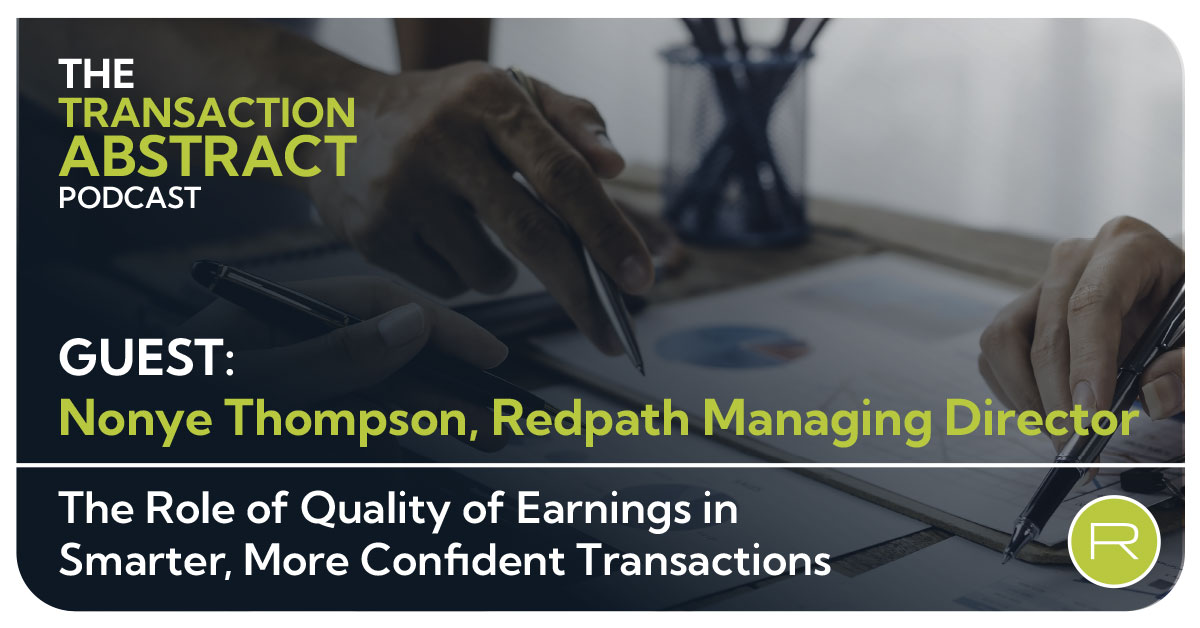The Role of Quality of Earnings in Smarter, More Confident Transactions
In this episode of The Transaction Abstract Podcast, Joe Hellman sits down with Nonye Thompson, Managing Director in Redpath’s Transaction Advisory...
![Corporate Development’s Role in M&A [PODCAST]](https://www.redpathcpas.com/hubfs/Blog%20Images/Corporate%20Dev.jpeg)
In a recent episode of The Transaction Abstract, Joe Hellman talked with Chad Nibbelink, a long-time corporate development officer in the Twin Cities with experience across multiple industries, types of deals, and deal sizes. Chad offers insights on strategic versus financial deals, corporate development’s role in ensuring a smooth transaction, and the post-close integration process.
There are many different types of buyers who pursue M&A transactions. Broadly, they fit into either strategic or financial in nature. Those categories can be subdivided down even more. For example, there are strategic buyers backed by private equity who will have their own unique approach to a deal.
For private equity buyers, a transaction is typically viewed as a shorter term investment, says Chad.
“When they're buying a company, they're already looking towards their next exit,” says Chad. “That's going to be a three to seven year horizon typically. They're buying you for a certain EBITDA multiple and they're hoping to increase your EBITDA and expand the multiple.”
To get there, they expect to accelerate revenue, increase margins, and reduce costs. They may, or may not, enlist active support from current ownership to do that.
Strategic buyers are current operators within the industry or adjacencies looking to compliment their existing operations. They want synergies and expansion. Most (but not all) strategic buyers are corporate buyers.
“Strategic buyers have a much longer horizon,” says Chad. “When they're buying a company, they're looking to fill a capability gap and they're looking to hold that thing forever, for lack of a better term. So their horizon could be 10 to 50 years.”
Owners of the acquired company typically do not stay on with the new entity except for a transitional period to keep the business stable.
For corporate, Chad says the value is primarily derived from two buckets:
Cost efficiencies also come into play. Corporate buyers typically have advantages here in terms of scale, especially in transportation and procurement, and through cost synergies that result from eliminating redundant or overlapping functions. Cost synergies not only streamline operations, they help pay for the acquisition.
Chad recalls a study back in the mid-90s/ early 2000’s that revealed 70-80 percent of acquisitions fail to deliver on expected value creation. “The acquisition might not have fit the strategic purpose that the company needed in the first place,” Chad explains. “But second, and more importantly, once close happened, the company lost sight of how difficult integration was going to be.”
The corporate development group (which could be just one person or several) is responsible for keeping the company’s eye on the ball.
A clearly articulated vision of what is desired in the short, medium, and long terms can be used as a checklist to evaluate potential targets. Understanding your company's processes, data flow, metrics, and more all feed into a greater integration plan. There is always a baseline plan that must be tailored to the situation of the acquisitions; a one size plan does not fit all.
Typically the vice president of corporate development represents company leadership throughout the transaction process and keeps an eye on whether the desired strategy is being followed. They will be guided by questions like these:
The goal is to find an acquisition target that can fill key gaps or expand current capabilities (new markets, complimentary products, and/or new customers). Corporate development oversees the due diligence and negotiation processes so top executives can stay focused on running their business units. Without corporate development proactively managing this process, says Chad, it would likely stall.
In what Chad calls a gated process, corporate development meets with leadership at key points to ensure the C-suite is fully informed of progress and gives their approval to move to the next step.
Finding “top talent” at the enterprise level is much the same as any high-level recruiting search. With the strategic goal in mind, corporate development can use:
The top of the funnel may hold dozens to hundreds of companies, but corporate development very selectively pares that down, looking for a good fit and strong financial return.
Even as corporate development is working with leadership to achieve a closed deal, they are also preparing for integration that has to start seamlessly on day one after close. Chad notes that it is essential that “corporations have a really detailed, actionable integration plan going forward.” After all, he says, “that’s where it gets into realizing those synergies. A lot of transactions don’t hit because you don’t necessarily have the right integration plan or you haven’t started as quickly as you should.”
Assigning an integration lead is vital, so there is someone responsible to ensure targets are hit. Who gets this assignment? Corporate development.

In this episode of The Transaction Abstract Podcast, Joe Hellman sits down with Nonye Thompson, Managing Director in Redpath’s Transaction Advisory...

In this episode of The Transaction Abstract Podcast, Joe Hellman sits down with Dan Hennessey, the newly appointed CEO of Sam Schwartz Pedestrian...
![Common Legal Pitfalls in M&A Transactions with Kim Lowe [PODCAST]](https://www.redpathcpas.com/hubfs/Podcast-Legal-Pitfalls-Kim-Lowe.jpg)
In this episode of The Transaction Abstract Podcast, Joe Hellman sits down with Kim Lowe, Partner at Avisen Legal, to discuss the most common legal...